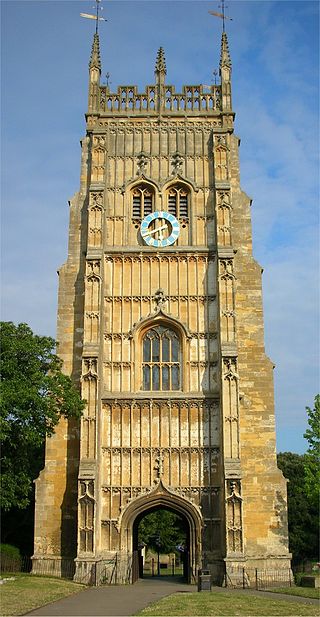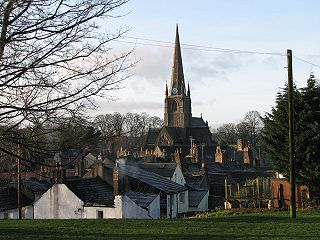
Cockermouth Castle (grid reference NY123309 ) is in the town of Cockermouth in Cumbria on a site by the junction of the Rivers Cocker and Derwent. It is a Grade I listed building and a scheduled monument. [1]

Cockermouth Castle (grid reference NY123309 ) is in the town of Cockermouth in Cumbria on a site by the junction of the Rivers Cocker and Derwent. It is a Grade I listed building and a scheduled monument. [1]
The first castle on this site was built by the Normans in 1134. [2] Some of the stone was sourced from the Roman site of Derventio (now Papcastle). Significant additions were made in the 13th and 14th centuries. [2] The castle played a significant role in the Wars of the Roses, and in the Civil War, when it was badly damaged. [2]
Various magnates held the castle, most prominently the Percy Earls of Northumberland from the 15th to 17th centuries. [3] It passed to the Wyndham family, the current owners, in the 18th century.
The castle was the home of the dowager Lady Egremont until her death in 2013. [2]
Cockermouth Castle was one of 135 sites from North West England included on the Heritage at Risk Register, maintained by English Heritage and later Historic England. The entry noted that the "Majority of Castle in good repair. The C13 Bell Tower is badly leaning and potentially dangerous. The C14 Kitchen Tower is suffering from water ingress". [4] The conservation situation was exacerbated in December 2015, when northern England experienced historically heavy rainfall triggering flooding. The flood defences at Cockermouth were overwhelmed, [5] and the weather caused a landslide near the castle, with the river washing away part its bank; Historic England noted that there was a clear risk to the historic structure. [6] The riverbank was reinforced but a permanent solution has yet to be agreed as of 2022. [7]
The castle has been opened to the public as part of the Heritage Open Days scheme. [2]

Evesham Abbey was founded by Saint Egwin at Evesham in Worcestershire, England between 700 and 710 following an alleged vision of the Virgin Mary by a swineherd by the name of Eof.

Cockermouth is a market town and civil parish in Cumbria, England, so named because it is at the confluence of the River Cocker as it flows into the River Derwent. The mid-2010 census estimates state that Cockermouth has a population of 8,204, increasing to 8,761 at the 2011 Census.

Brough, sometimes known as Brough under Stainmore, is a village and civil parish in the Westmorland and Furness unitary authorty of Cumbria, England, on the western fringe of the Pennines near Stainmore. The village is on the A66 trans-Pennine road, and the Swindale Beck, and is about 8 miles (13 km) south east of Appleby-in-Westmorland. Brough is situated 5 miles (8.0 km) north east of Kirkby Stephen and 28 miles (45 km) north east of Kendal on the A685.

Muncaster Castle is a privately owned castle overlooking the River Esk, about a mile east of the west-coastal town of Ravenglass in Cumbria, England. It is recorded in the National Heritage List for England as a designated Grade I listed building.

Dalton Castle is a grade I listed 14th-century peel tower situated in Dalton-in-Furness, Cumbria, England, and in the ownership of the National Trust. It was constructed by the monks of Furness Abbey for the protection of the nearby market town, and was the building from which the Abbot administered the area and dispensed justice.

Wordsworth House is a Georgian townhouse situated in Cockermouth, Cumbria, England, and in the ownership of the National Trust. It was built in the mid-18th century. William Wordsworth was born in the house in 1770. The house is a Grade I listed building. It is open to the public as a writer's house museum from March to October each year.

Appleby Castle is in the town of Appleby-in-Westmorland overlooking the River Eden. It consists of a 12th-century castle keep which is known as Caesar's Tower, and a mansion house. These, together with their associated buildings, are set in a courtyard surrounded by curtain walls. Caesar's Tower and the mansion house are each recorded in the National Heritage List for England as a designated Grade I listed building. The uninhabited parts of the castle are a scheduled ancient monument.

Gleaston Castle is a medieval building in a valley about 1 kilometre (0.62 mi) north-east of the village of Gleaston. The village lies between the towns of Ulverston and Barrow-in-Furness in the Furness peninsula, Cumbria, England. Gleaston Castle has a quadrilateral plan, with a tower at each corner. The largest of these, the north-west tower, probably housed a hall.

Moresby Hall is a former manor house and hotel in Parton, Cumbria, England, overlooking the Cumbrian Fells, and just to the north of the village of Moresby.

Rose Castle is a 16,244 square feet (1,509.1 m2) fortified house in Cumbria, England, on a site that was home to the bishops of Carlisle from 1230 to 2009. It is within the parish of Dalston, 1.5 miles (2.4 km) from Dalston itself, which is four miles southwest of Carlisle. The architects Anthony Salvin and Thomas Rickman were responsible for the alterations which took place in the 19th century.

Burneside Hall is a converted medieval pele tower in Burneside, Cumbria, England.

Branthwaite Hall is pele tower in Cumbria, England, considered by historian Anthony Emery to be "one of the best-preserved early houses in Cumbria".

Arnside Tower is a late-medieval tower house between Arnside and Silverdale immediately to the south of Arnside Knott in Cumbria, England.

St Lawrence's Church is in Boroughgate, Appleby-in-Westmorland, Cumbria, England. It is an active Anglican parish church in the deanery of Appleby, the archdeaconry of Carlisle, and the diocese of Carlisle. The parish is one of ten parishes which form the Heart of Eden benefice. Sunday worship is at 10.45am and on Fridays at 10am. The church is recorded in the National Heritage List for England as a designated Grade I listed building.

St Andrew's Church is in the village of Dacre, Cumbria, England. It is an active Anglican parish church in the deanery of Penrith, the archdeaconry of Penrith, and the diocese of Carlisle. The church is recorded in the National Heritage List for England as a designated Grade I listed building. The church stands near to Dacre Castle.

St Oswald's Church is in the village of Ravenstonedale, Cumbria, England. It is an active Anglican parish church in the deanery of Appleby, the archdeaconry of Carlisle, and the diocese of Carlisle. Its benefice is united with those of All Saints, Orton, and St James, Tebay. The church is recorded in the National Heritage List for England as a designated Grade I listed building.

Rampside Hall is a Grade I listed building in the Rampside area of Barrow-in-Furness, Cumbria, England. It is one of only three Grade I listed buildings in the Borough outside of the Furness Abbey complex and dates back to the 17th century. Built for the Knype family, it is most noted for its dozen chimneys which have given the building the nickname 'the twelve apostles'. Rampside Hall retains the majority of its original features, with the only major alteration taking place in 1810 when the building was re-roofed. The building was heavily damaged on 15 February 1865 when a 2.2ML earthquake shook the area, toppling three of its famed chimneys, cracking walls and displacing some of them by eight inches.
Brackenhill Tower is a peel tower, in the parish of Arthuret, in Cumbria, just north of the River Lyne. The site is about 2 miles (3.2 km) north of Kirklinton and 4 miles (6.4 km) east of Longtown, or 10 miles (16 km) north of Carlisle and 8 miles (13 km) east of Gretna Green, and is a good defensive position, with ravines to the north and south. Extensions were added in the 18th and 19th centuries, but the original tower has had little alteration. It is the only remaining example of a Scottish tower house south of the border with England, and became a grade II* listed building in 1957.

Workington Hall, sometimes called Curwen Hall, is a ruined building on the Northeast outskirts of the town of Workington in Cumbria. It is a Grade I listed building.

Millom Castle is an ancient building at Millom in Cumbria. It is a Grade I listed building and scheduled ancient monument.
Coordinates: 54°39′56″N3°21′40″W / 54.66552°N 3.36122°W